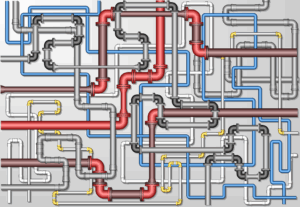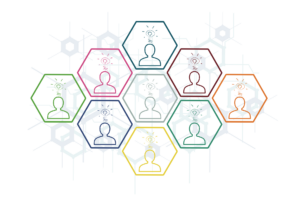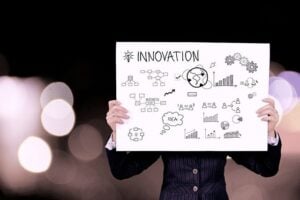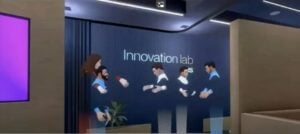Talent & Business Trends
Technological, generational and social shifts will impact the world of work over the next decade. This could range anywhere from the types of devices we are using everyday to the ability to work remotely from literally anywhere. Clearly, hybrid and remote work continues to cement its place in the “new normal” of the workplace. This will also be influenced by the competitive talent landscape, the pressure to control costs and the rise of automation, among other trends, according to Gartner’s recent studies.
The workplace culture might be one of the key concerns when it comes to office and work-from-home policies of the future. For innovation leaders and their teams, hybrid strategies have been compelling them to adjust their culture and ecosystems and to be more supportive of their employees.
This new future of work will be impacted by both talent and business trends taking shape. On the talent side, notes Gartner, is the move towards human-centric work design; a reshaping of the culture; managing in a hybrid world; and digital enablement. On the business side, this also includes the rethinking of the workplace and the shifting of talent and skills.
Gartner further looked at “9 Future of Work Trends for 2023.” Developed by Emily Rose McRae and Peter Aykens, the trends offer a least a glimpse into some of the potential workplace shifts moving forward. Just how innovators and company leadership might respond to such trends is significant if they want to build a flexible and agile workforce and a culture for the future. Whether in the office or remote, or a hybrid strategy, this workforce of the future will need to collaborate and innovate to help them succeed in their research and development projects.
Collaboration is Key
There is a great deal of research into the future of work and possible trends that are impacting the workforce today and beyond. But just how can leaders in innovation adapt and succeed now? McKinsey offers some insights in its article, “What is the future of work?” Looking at the hybrid strategies that are becoming more common today, McKinsey offers some key takeaways that innovation leaders and organizations can do now to refine their operating models.
1. Expand executives’ focus on strategic clarity, coaching, and empathy. The leading driver of performance and productivity isn’t compensation or stretch goals but rather the sense of purpose work provides to employees. Be more intentional about interactions, especially those that happen in person.
2. Foster outcome-based management of small, cross-functional teams. This is both more human and more effective as performance management practices shift from being about controlling employees’ work to empowering and enabling teams and people to perform.
3. Increase talent velocity, especially with reskilling. Being able to staff teams across organizational siloes is a hallmark of agile models. Moving in this direction for talent management might entail developing internal talent marketplaces or hubs for talent redeployment that make it easier for people to discover potential projects. It will also involve reskilling and upskilling people more quickly than in the past, leaning on formal training, as well as apprenticeship and mentoring.
4. Find new zero-cost, high-optionality ways to collaborate. It can help to define a model to increase how quickly your organization can discover and adopt better modes of collaboration, both physical and digital. Do workers need an informal, confidential channel for banter or guidelines on making hybrid meetings more effective? Be intentional about designing these interactions and communicating expectations and working norms.
5. Increase the rate of technology adoption. It’s imperative for companies to seek out new tech and use data to drive optimal results and make better decisions.
Growing Innovation Culture
The approach to innovation talent has evolved in this new globalized work world. While common themes have emerged, different organizations have chosen distinct paths. In this Innovation Talent Roundtable, Seth Adler spoke with the innovation community, which shared several thoughts on the search for innovation talent and fostering a culture of innovation.
Igniting innovation culture and talent is fraught with danger as, if you’re not careful, it can lead to burnout. Finding innovation talent that fits within a given organization is, to put it simply, challenging. Good innovation talent itself is elusive. Add to the equation that a given person not only needs to have the specific skill set being sought, but that same person must fit with corporate and innovation culture already established.
Welcome to the Future of Work
The future of work has a significant impact on innovation. As work environments evolve and adapt to emerging technologies, changing demographics, and evolving expectations, the way innovation is approached and implemented undergoes transformation. We asked ChatGPT to sharpen our focus on several ways in which the future of work influences innovation:
1. Remote and Distributed Work: The rise of remote and distributed work arrangements enables organizations to tap into a broader talent pool and collaborate with individuals from diverse backgrounds and locations. This diversity and access to talent can foster innovation by bringing together varied perspectives, experiences, and expertise. Remote work also encourages the adoption of digital collaboration tools, which facilitate real-time communication and idea sharing, further supporting innovation.
2. Flexible Work Culture: The future of work emphasizes flexibility in terms of work hours, location, and arrangements. Flexibility allows employees to structure their work in a way that suits their productivity and personal preferences. This freedom can stimulate innovation by providing individuals with the autonomy and space to explore new ideas, experiment, and take risks. A flexible work culture also fosters a more inclusive and diverse workforce, which is known to drive innovation.
3. Cross-functional Collaboration: As organizations increasingly embrace interdisciplinary and cross-functional collaboration, innovation benefits from the exchange of ideas and expertise from different fields. By breaking down silos and encouraging collaboration among teams with diverse skill sets and backgrounds, organizations can foster a culture of innovation and harness collective intelligence to solve complex problems.
4. Agile and Iterative Approaches: The future of work promotes agile methodologies and iterative approaches to project management and innovation. Agile methods emphasize continuous learning, experimentation, and adaptation, enabling teams to quickly respond to changing market dynamics and customer needs. This iterative mindset encourages experimentation, failure tolerance, and rapid prototyping, leading to accelerated innovation cycles and the ability to bring new ideas to market faster.
5. Automation and Artificial Intelligence (AI): The integration of automation and AI technologies in the future of work has a profound impact on innovation. Automation frees up employees from repetitive and mundane tasks, allowing them to focus on more creative and strategic endeavors. AI technologies can analyze vast amounts of data, identify patterns, and generate insights, providing valuable inputs for innovation. AI-powered tools can also support ideation, prediction, and decision-making processes, contributing to more informed and effective innovation efforts.
6. Upskilling and Reskilling: The future of work necessitates continuous upskilling and reskilling of employees to keep pace with technological advancements and evolving job requirements. Organizations that invest in developing their employees’ skills create a culture of learning and innovation. By equipping employees with the necessary knowledge and competencies, organizations foster a workforce that is better equipped to generate and implement innovative ideas.
7. Emphasis on Human-Centered Design: The future of work places a greater emphasis on human-centered design principles, which prioritize understanding and addressing the needs, desires, and challenges of end-users. By involving end-users in the innovation process, organizations can develop solutions that truly meet their expectations and deliver meaningful experiences. Human-centered design approaches such as design thinking and user experience research help organizations uncover unmet needs and drive innovation in a customer-centric manner.
The Future of Work Is Now
In some ways, the future of work is already here for those in innovation that embrace collaboration and foster an open and holistic culture. The future of work significantly impacts innovation by enabling remote and distributed work, fostering flexibility, encouraging cross-functional collaboration, promoting agile and iterative approaches, leveraging automation and AI technologies, emphasizing upskilling, and embracing human-centered design. Embracing these shifts in the work environment can unlock new opportunities for innovation, enhance organizational agility, and drive competitive advantage.
Video courtesy of Gartner
Contributor
-

Matthew Kramer is the Digital Editor for All Things Insights & All Things Innovation. He has over 20 years of experience working in publishing and media companies, on a variety of business-to-business publications, websites and trade shows.
View all posts










































































































































































































